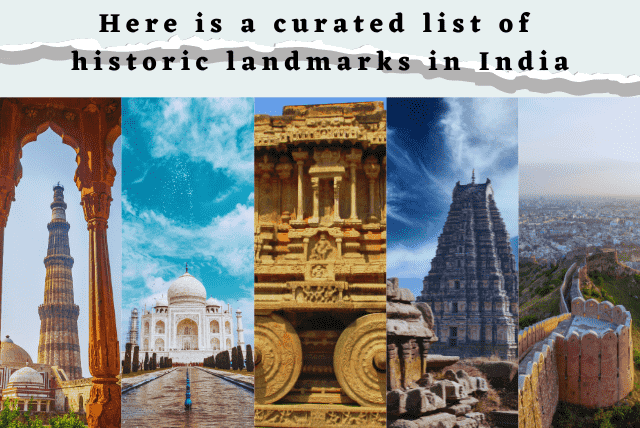India is a vast country rich in history and culture. It's home to many historic landmarks, each with its own unique story to tell. These sites offer a glimpse into India's diverse heritage, from ancient civilizations to the modern era. Here is a curated list of historic landmarks that every history enthusiast should visit.

But before embarking on this fascinating journey, one of the essential steps is securing an Indian Visa. It's a simple, online process that makes traveling to India a breeze. This allows visitors from around the world to experience India's grand history up close and personal. Prepare yourself for a remarkable journey into the past that's both educational and breathtaking.
1. Taj Mahal, Agra
Arguably the most recognizable symbol of India, the Taj Mahal is a must-visit for any traveler. This magnificent white marble mausoleum was built by Mughal emperor Shah Jahan in memory of his beloved wife Mumtaz Mahal. Its beauty and grandeur are a testament to the rich architectural style of the Mughal period.
2. Qutub Minar, Delhi
The Qutub Minar is a 73-meter tall minaret that forms part of the Qutb complex, a UNESCO World Heritage Site in Delhi. It is the tallest brick minaret in the world and an important example of Indo-Islamic architecture.
3. Ajanta and Ellora Caves, Maharashtra
The Ajanta and Ellora caves are a group of rock-cut Buddhist, Jain, and Hindu temples and monasteries that date back to the 2nd century BC. The detailed carvings and frescoes found here are considered masterpieces of Buddhist religious art.
4. Hampi, Karnataka
Hampi was the capital of the Vijayanagara Empire in the 14th century. Today, it's a UNESCO World Heritage Site known for its ruined temple complexes that showcase the Dravidian style of South Indian architecture.
5. Konark Sun Temple, Odisha
The Konark Sun Temple is a 13th-century temple dedicated to the Sun God. It's known for its intricate stone carvings and its chariot-shaped structure, which is an architectural marvel.
6. Khajuraho Temples, Madhya Pradesh
The Khajuraho Temples are known for their intricate erotic sculptures and are considered one of the "Seven Wonders" of India. The temples were built between 950 and 1050 by the Chandela dynasty and represent one of the high points of Indian artistic expression.
7. Sanchi Stupa, Madhya Pradesh
The Great Stupa at Sanchi is the oldest stone structure in India, originally commissioned by the emperor Ashoka the Great in the 3rd century BCE. It's an important monument of Buddhist art and architecture.
8. Jaisalmer Fort, Rajasthan
Situated in the heart of the Thar Desert, Jaisalmer Fort is one of the largest fully preserved fortified cities in the world. Known as the "Golden Fort," it gets its name from the yellow sandstone used in its construction. The fort is a living monument, with a significant population residing within its walls.
9. Fatehpur Sikri, Uttar Pradesh
Fatehpur Sikri, the city of victory, was the capital of the Mughal Empire for only 10 years. Despite its brief history, the city houses some of the finest examples of Mughal architecture. The city was declared a UNESCO World Heritage site in 1986.
10. Mahabodhi Temple, Bihar
The Mahabodhi Temple Complex in Bodh Gaya is one of the four holy sites related to the life of the Lord Buddha, marking the spot where Buddha achieved enlightenment. The site houses a descendant of the Bodhi Tree under which Buddha gained enlightenment, making it a significant pilgrimage site for Buddhists worldwide.
11. Rani ki Vav, Gujarat
Rani ki Vav is an intricately constructed stepwell situated in the town of Patan in Gujarat. Built as a memorial to an 11th-century king Bhima I by his widowed queen, it was added to the list of UNESCO's World Heritage Sites in 2014.
12. Chola Temples, Tamil Nadu
The Great Living Chola Temples, which include the Brihadeshwara Temple at Thanjavur, the Temple of Gangaikondacholisvaram, and the Airavatesvara Temple at Darasuram, are a testament to the architectural, artistic, and technological achievements of the Chola Dynasty.
13. Jaipur City, Rajasthan
Known as the Pink City, Jaipur is a vibrant amalgamation of the old and the new. The city, founded in 1727 by Jai Singh II, is home to a plethora of historically and culturally significant landmarks such as Hawa Mahal, City Palace, Jantar Mantar, and Amer Fort.
Note:
These are just a few examples of the rich historical landmarks that India has to offer. Each site provides a unique insight into the diverse cultures and civilizations that have contributed to the country's rich tapestry of history. By visiting these landmarks, history enthusiasts can gain a deeper appreciation for the complexity and beauty of India's past.
Each of these historic landmarks allows you to journey back in time and explore the rich cultural heritage of India. Their architectural grandeur, the stories they hold within their walls, and the historical events they have witnessed make them must-visit destinations for history enthusiasts and casual tourists alike. Exploring these sites is akin to opening a living history book, where each page unravels a new chapter of India's diverse and fascinating past.